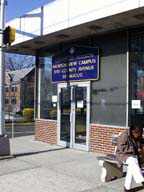Secaucus didn’t just see a 13.3 percent increase population, according to numbers released by the U.S. Census Bureau, in March, but a change in the racial makeup of people living here.
Although shifts in population had been evident in the 1980s, the 2000 census showed a major shift in racial population during the 1990s.
In 1980, Secaucus had a population of 12,849, of which 98.2 percent were white. In 1990, the population rose to 15,931, with 91.79 percent listed as white. In 2000, the population again rose to 15,931, with only 78.54 percent listed as white.
This 13.25 percent change nearly matched the change in Hudson County, which saw a 13.24 percent drop in its white population over the last decade.
The population of Latinos showed a significant rise. In 1980, Secaucus had a 3.3 percent Latino population. In 1990, this percentage rose to 7.49. The 2000 census showed Secaucus with 12.26 percent Latino population, or about a 4.45 percent increase from 1990. This is slightly below the county average of 6.59 percent increase in this category.
The number of people listed as black has also risen significantly in Secaucus. In 1980, blacks made up less than a half percent of the population in Secaucus. In 1990, blacks made up 2.39 percent, and in 2000, this figure rose to 4.62 percent, a rise of 2.23 percent over the last decade.
Asians also made significant population gains in Secaucus. In 1980, Asians accounted for only 1 percent of the population of Secaucus. In 1980, Asians made up 4.91 percent. In 2000, the Asian population jumped by 7.49 percent to 12.4 percent of the populations, but still below the increase of 10.09 percent shown throughout Hudson County.
Biggest impact is on the schools
Secaucus officials – particularly those in the school district – said they were well aware of these changes, and that they affected the schools the most.
“We have seen a rise in Latino and Korean populations since I became principal in 1997,” said Secaucus High School Principal Pat Impreveduto.
Impreveduto said that more students are entering the district who don’t speak English as a first language, and that this might reduce the district’s overall test scores, which are used to determine the job the district is doing. “We won’t see a drop in mathematics because that really is a universal language, but we will see language arts affected,” Impreveduto said. “Reading and writing scores will show be affected because for most of these students, English will be a foreign language.”
The school district, he said, will have to take action to help these students.
“What this means is that we have to increase our English as a Second Language programs, and down the road, perhaps hire teachers who are bilingual,” he said.
This will also likely involve finding teachers who are certified in ESL as well.
Board member Michael Schlemm, a graduate of Secaucus high school in 1983, said a significant change has occurred, especially in the schools.
“When I was in school, we didn’t see a black student until I was a sophomore in high school,” he said. “We only had one or two Asians.”
Schlemm said that the schools will have to find ways to deal with how to meet the language requirements of the students who don’t speak English as a first language.
“We’re not talking just Spanish, it’s other languages, too,” he said. “Being in Hudson County, we’re going to get impacted by immigrations trends. This is not necessarily bad, but we’re going to have to work to provide the kind of education, these students need.”
Political impact
The census may have an unexpected impact on the political divisions within the town. Secaucus has three wards, and according to state election laws, their population must be within 10 percent of each other. The census, according to Mayor Dennis Elwell, showed a rise in the 1st Ward, which could result in a shift of some sections from the 1st Ward to the 2nd.
The census showed the 1st Ward with a population of 5,778, 2nd Ward, 4,909 and 3rd Ward, 5,244.
“The town clerk will have to sit down with county officials to see what has to be done,” Elwell said.
People in facilities were included
Secaucus, like Kearny, will feel the impact of a change in the 2000 Census that required residents of county and state institutions to be counted in the local community rather than from the places where they formerly resided. Thus prisoners incarcerated in the Hudson County Correctional Facility were counted as residents of Kearny. In Secaucus, which houses the Hudson County Juvenile Detention Facility, the Hudson County Mental Facility, as well as Integrity and Turning Point drug rehabilitation programs, the impact may be nearly as great. All of these facilities are contained within the first ward and according to voting records, only one or two residents from the mental facility actually vote.
These considerations aside, Elwell said the census showed the population numbers of Secaucus more or less stable over the last 10 years.
“Looking around at the newer housing, we could more or less predict the numbers before we got the results,” Elwell said.
